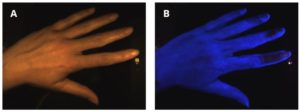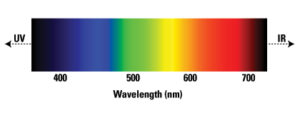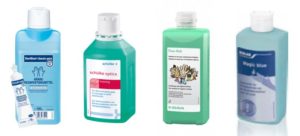What is the fluorescent trial and how can we apply it?
For testing one’s hand hygiene, the two most commonly used methods are the microbiological sampling and the fluorescent dying method. In this post, we discuss the fluorescent method in details.
The fluorescent method was developed to assess the hand hygiene technique. Health-care workers should perform handrubbing as they usually do, the only difference is that the handrub contains a fluorescent dye. After the hand hygiene event, hands should be placed under (harmless) UV-A light. Regions of hand surface treated with proper amount of fluorescent handrub glow, where untreated areas remain dark.

Figure 1: Images of a hand recorded in visible light (A) and in UV light (B) during the fluorescent method.
(Source: HandInScan)
The phenomenon of fluorescence occurs when a substance (the dye) absorbs light (energy) and instantly reemits light at a longer wavelength. In this special case, the absorbed light is in the ultraviolet region and thus invisible to the human eye, but the emitted light is visible, as blue.

Figure 2: The visible spectrum of light. Source: ThermoFisher Scientific
Fluorescent dye containing ABHR (alcohol-based handrubs) are commercially available. Some of them are presented in Figure 3.

Figure 3: Some of the commercially available fluorescent dye containing handrubs.
From left: BODE Visirub dissolved in Sterillium, Schülke Optics, B. Braun Fluo-Rub, and Ecolab Magic Blue
The traditional fluorescent assessment method needs a UV-A light source, UV-fluorescent dye containing handrub and a dark room environment, or the so-called ‘black box’ to exclude regular light. Fluorescence can be observed by the human eyes inside the box. Advanced settings allow taking record of the fluorescence for later evaluation. Semmelweis Scanner goes a bold step further, as it evaluates the recorded picture immediately.
Main advantages of the fluorescent method are the easy application, the immediate and visualized result and the relative cost-effectiveness. Thanks to these characteristics the method can be easily applied for medical education [1].
Conclusion:
The fluorescent method has been applied for more than a decade to help people improve hand hygiene technique. As it requires limited time and expenses, it became one of the most well-known and widely used methods. The Semmelweis Scanner is the newest, digital development of the fluorescent methodology.
Read our previous post on different composition of handrubs. Please stand by for our next blog entry on the possible application of the fluorescent method.